TSDK No. 58. Ten Leading Psychics Reveal Their Predictions for 1984
Supermarket Magazine Review: The National Enquirer
I
Welcome to the second installment of Supermarket Magazine Review, the series in which I conduct shamanistic spirit voyages into the soul of America via the medium of periodicals. In episode one I opened the gateway that is Prepper Survival Guide, and now, a mere two years later, here we are with episode II. Better late than never, etc.
This time around I will be reviewing the National Enquirer (Est. 1926). Not just any issue, however, but rather the one dated January the 3rd 1984, which I recently found bagged and boarded in an antique mall in Blanco, Texas.
Supermarket tabloids are not supposed to survive for forty years, so I was immediately intrigued as to what forgotten scandals might lie within its brittle pages. The front-page headline was extremely promising: 10 leading psychics reveal their predictions for 1984. I was excited at the prospect of the Enquirer channeling the dystopian zeitgeist. That was the year I learned about Orwell’s book from articles in my parents’ newspaper and TV trailers for the film adaptation starring John Hurt, although I wouldn’t read it until I was a teenager, several years later.
Besides these solemn mysteries, the Enquirer promised to reveal:
How to find and keep good friends
The key to a long life (sex, apparently)
Shocking surprises coming up on Dallas
How to “KO” agonizing headaches with a new drug
It was, to quote the late Robert Palmer, simply irresistible. I shelled out my $5 (plus tax) and took it home to read.
II
Alas, it turned out that the predictions for 1984 had nothing to do with Airstrip One, Ingsoc or the war with Eurasia. In fact, they were rather upbeat. Dorothy Allison, a psychic who purportedly helped the police solve murders, prophesied that the country's economy was going to improve, making everything better for everyone: “The year 1984 is going to bring great prosperity to the whole nation — unemployment will drop significantly and American factories will have full order books.” The other predictions, from Florence Vaty (who predicted Nixon’s resignation) and Frederick Davies (“who often advises top celebrities”) were for the most part sheer whimsy, e.g.:
Mr. T will be hit by lightning
Ted Kennedy will elope to Europe with his secretary
The ghost of John Lennon will save the lives of his widow Yoko Ono and their son Sean. When fire sweeps Yoko's Manhattan apartment Lennon’s spirit will wake her and Sean and lead them to safety
Tom Selleck will flip for sensuous Flashdance star Jennifer Beals
Pope John Paul II will again be the target of an assassin
Larry Hagman will drop out of Dallas and journey to Tibet to study mysticism under a powerful guru
A masked man will kidnap baby Prince William from his stroller as his nanny pushes him through a London park
A piano lid will slam shut on Liberace's fingers breaking them so he won't be able to play piano again for a year
Gary Coleman will grow taller thanks to secret injections
Etc.
Only the prediction that a vaccine against AIDs “the dreaded new killer disease” would be developed, hinted at real darkness. Yet despite or perhaps because of their fatuity, the predictions were nonetheless fascinating for providing a snapshot of what people were talking about back then; the hokum and blabber of celebrity gossip, the effluvium of whatever was on TV at the time. It was like finding a prehistoric dragonfly perfectly preserved in amber. Mr. T was a major celebrity (he appeared multiple times inside the issue), plot twists in Dallas were front page news (who shot JR?); Liberace was alive and in the closet; Gary Coleman was the cute kid on Diff’rent Strokes.
The tone was blithe, breezy; it was just a bit of fun. But there was a problem. Although the celebrity psychics were making it up for fun and profit, my own gift of foresight was absolute and unerring. Nobody in the issue knew what was going to happen to them, but from a distance of forty years I did. I knew that Liberace would die of an AIDs related illness three years later; I knew that Mr. T would tumble to the Z list and be diagnosed with lymphoma in 1995; I knew that Gary Coleman would sue his parents, go bankrupt, work as a security guard, and finally expire after falling down some stairs at the age of 42.
That gulf between their innocence and my knowledge of their respective dooms made reading the National Enquirer for January 3rd 1984 a profoundly existential experience; each page was heavy with fate. Certainly, it was a lot more harrowing than what I was accustomed to when reading the Enquirer. When I first moved to America, I regularly picked it up at the checkout in Walmart. It was a way of getting under the skin of my new home, while also indulging my appetite for gossip. The main storyline in those days was the fall of Whitney Houston. Each week there was an update on her fondness for crack, her relationship with Bobby Brown, the plight of her tragic daughter. It was pretty grim stuff, but while Houston was still alive you could tell yourself that there was always the possibility that the Enquirer was making some of it up. Instead, the facts were worse than what was reported. It’s all fun and games until somebody drowns in the bathtub.
III
In January 1984, Whitney Houston hadn’t even released her first single, so there were different storylines. There was a big spread on Steve McQueen’s secret meeting with Billy Graham mere days before he died, when he had received an inscribed Bible from the famed evangelist. Evidently McQueen’s charisma was such that the National Enquirer was still running articles about him years after his demise.
Yul Brynner, on the other hand, was still alive, and poised to deliver a sequel to Steve McQueen’s storyline. He, too, had cancer and was taking a break from his signature role in The King and I to travel abroad for “experimental” treatment. Unlike McQueen, who had subjected himself to coffee enemas in Mexico, Brynner was visiting a “controversial” German specialist whose treatment involved eating vegetables and drinking a lot of carrot juice. It didn’t work: Brynner died one year later. I looked up this German, a certain Dr. Hans Nieper. The death of his celebrity patient didn’t seem to have caused his practice any harm and he was active until his death in 1998, although in 2006 he was posthumously placed on a Quackwatch list, presumably in case anybody stumbled upon his books and was inspired to give carrots against cancer another go.
Then there was the budding romance between the “vivacious” actress Tuesday Weld (40) who was “making sweet music” with the classical violinist Pinchas Zukerman who was “five years her junior”. I knew Zukerman because I had bought a couple of his CDs on the clearance shelves at Half Price Books, and I also knew Tuesday Weld, although I wasn’t sure why. When I looked her up on Wikipedia the only films of hers that I recognized were Looking for Mr. Goodbar, a bleak film from the 1970s in which Richard Gere plays a sociopath who rapes and murders Diane Keaton, and Once Upon a Time in the West. Perhaps it was the marriage to Dudley Moore that had planted her name in my memory, or the relationships with Al Pacino, Omar Sharif, Richard Gere et al. Regardless, I got the impression that the Enquirer was covering this story not because Weld and Zukerman were big stars but rather for the sheer unlikeliness of the pairing. Still in the early days of their romance, Zukerman and Weld did not know what lay in store for them. But I did. Zukerman would leave his wife and two children for Weld. They would get married in 1985, but the relationship would end in divorce in 2001. Weld, it seems, didn’t like classical music all that much. According to the divorce papers, she complained "Why do I need to go to another concert when I've heard the piece before?"
I caught glimpses of other storylines, some of which would run for decades. Arnold Schwarzenegger was on the way up, dating Maria Shriver, blissfully unaware that he would one day impregnate the maid and blow up the world he had carefully constructed. And there was Lisa Marie Presley, getting her first taste of fame in a guest spot on Dallas, long before the marriages to Michael Jackson and Nicolas Cage, the scientology, the opioid addiction, the suicide of her son, and, finally, death by small bowel obstruction at the age of 53.
But perhaps the saddest story of all was the one featuring Barbara Stanwick's adopted son, Anthony Dion Fay, who was pleading for one more meeting with his mother before she died. “She threw me away like so much garbage, she never touched, kissed or held me except when cameras flashed,” he said. It was an incredibly bleak story of neglect and cruelty, made all the more unpleasant by the fact that although he thought he was the protagonist of this story, as far as the Enquirer was concerned, his was just a walk on-part in his mother’s epic saga, which stretched back to the 1920s. Stanwyck died six years later, leaving instructions that he was not to be allowed near her deathbed. Fay himself would die in 2006 at the age of 76. If you Google him, you will find that precious little information about his life survives—except that he was once arrested for selling pornography to minors.
I realized then that in the 1980s, many of the stars of the golden age of Hollywood were still alive, and that even if they were no longer in the movies, they still provided tabloids with fodder for ancient storylines that had been running for so long the first installments might as well have been inscribed on clay tablets. But the curtain was about to fall on all of those stories, too.
IV
Of course, the National Enquirer also publishes “human interest” stories about ordinary people who do extraordinary things, or who have an particularly poignant life story. These are short stories rather than serial storylines, and here my gifts of foresight broke down.
For instance, although I wanted to know what happened to the man who ate glass (“it's like biting a chunk of crisp delicious apple”), I could find no trace of him on the Internet. Did Ihesha, the “mildly retarded” “obedient” 14-year-old girl with cerebral palsy ever get adopted? I had no way of knowing. And what about Murray, the “human vegetable” who had been unable to use his paralyzed legs or arms for 35 years? He dreamt he could walk and started walking. Was he still walking? Or was he dead? And what about Martha Smith, the gun-slinging SWAT granny from San Bernardino? Or Mark Pearson, 23, who blasted his dad Mack with a shotgun but got let off with a fine by a ridiculously liberal judge? They had all escaped into time.
The “Russian doctors” who discovered that remaining sexually active after the age of 60 could add eight to ten years to your life had also disappeared. The Enquirer reported that the Soviet Institute for the Study of Longevity was located in Sukhumi, the capital of Abkhazia, and none of the scientists or sexually active seniors living in that subtropical republic could have imagined that the USSR would cease to exist within seven years, or that neighbor would murder neighbor in a bloody war of secession from Georgia. Dr. Semyon Dalaskashvili, and his colleague Dr. Shota Gogokhia, both quoted in the article, would be very old men by now—if they survived.
Some of the people I could find, however — if they had a desire to be famous. For instance, Jim “the mouth” Purol, who could fit 38 pipes in his mouth and had three entries in the 1984 Guinness Book of Records, was still working his schtick decades later, available for parties and generally floating about on the Internet. Then there was Michael Hughes, who for four years had burgled the homes of the Hollywood elite, including Farrah Fawcett, (from whom he stole some jewelry) and Joseph Cotton (from whom he stole some beer steins). After spending eight months in prison he made a training film for the Beverly Hills Police Department, became a karate instructor, dabbled in filmmaking and thirty years later was still milking his brief notoriety, appearing as a talking head on Piers Morgan Tonight on 2013.
But by far the most interesting human interest story was that of Ossian Maclise, an all-American boy “in sneakers” who at age four was recognized as the reincarnation of Sangye Nyenpa Rinpoche (1457-1525) and sent to live in a monastery in Nepal by his parents: “Each morning, the American-born teenager rises at 4 a.m., washes in cold water, then he spends most of the day studying Buddhist scriptures and ceremonies, sitting cross-legged on the floor for hours on end.”
The Enquirer reported that on Saturdays his mother would show up and take him to a friend’s house to watch movies on VHS; he liked Raiders of the Lost Ark so much that he watched it five times. Although the report was written in a gee whiz, “Ripley’s Believe It Or Not” style, I found the thought of a little boy being packed off to a monastery by itinerant hippy parents rather appalling.
What had become of him? I searched online and quickly found out that his father was Angus Maclise (d.1979), the first drummer in the Velvet Underground, and that his mother, Hetty Maclise (d. 2011) was also celebrated in counterculture circles. The pair of them had got up to all sorts of psychedelic and occult shenanigans back in the day.
As for Ossian’s fate, information was a lot harder to come by. A documentary, Ossian: American Boy, Tibetan Monk was released in 1990, and then, it would seem, silence — until Ossian himself created a Facebook page in 2009. There are only two posts and the last one went up in 2014: “All buddhas past present and future, have one essence. intuiting this essence you know your own mind's nature. let go and relax into unstructured reality. and with constant relaxation. maha siddha aryadeva one eyed one.”
Ossian is actually one of two claimants to be the reincarnation of Sangye Nyenpa Rinpoche. He is now 57 years old, and—if his Facebook page is anything to go by—still in Kathmandu.
V
Ads, of course, become more interesting over time: little portals into the past that reveal so much. The wants, pains and yearnings never really change, but their manifestations do. The ads in The National Enquirer were so interesting that I found myself reading each and every one of them, which greatly slowed down the pace at which I was able to make it through the issue.
The ones for cigarettes were particularly striking. Full page, full color photos of men and women skiing, or frolicking with horses. Bright brand cigarettes promised “The taste that outshines menthol—and leaves you with a clean, fresh taste.” Newport cigarettes were “alive with pleasure” and illustrated the fact with a photo of shirtless alpha male hoisting a girl dressed in warm winter clothes over his shoulders while standing in a swimming pool: “After all, if smoking isn’t pleasure, why bother?” I liked, too the ad for the John Wayne poster (free!), Eva Gabor wigs by mail (any style, $19.99), figure trimmer corsets (hide pounds unbelievably fast, only $6.98), the “smooth away” electric callus eraser ($7.99) and the unbranded “hooded jacket” ($19.95, weather any storm!)
Best of all were the ads for mysterious talismans that would bring you good fortune. The claims were so ludicrous, it was amazing to think they were legal. “Rub the Buddha” for luck when you “need a real money miracle”, a personal sun-sign horoscope individually prepared from scratch for just $3; seven miracle magic dolls in the tradition of Africa's ancient secret rituals; “R. Donald Papon, also known as Zolar the world-renowned mystical scholar explains How the Long-Lost Power of ABRAXAS Can MAKE TOMORROW THE LUCKIEST DAY OF YOUR LIFE.” You had to give the good doctor $10 in exchange for which he would send you a mystical amulet (“we are sorry but the sacred carvings appearing on the back cannot be shown here”). My favorite was a full-page ad for something called “Biorhythm analysis” which was disguised to look like an article. There was a preposterous story about “Ruth Wilson of California” who had only won a “single small contest” in all her 58 years until August 1977 when she “discovered the good luck secret of Biorhythm.” Since then she had won $16,000 in prizes, including a “1977 Camaro worth over $7000, portable radios, a brand new set of golf clubs and a 22-foot Crestline stern drive motorboat.”
It sounded amazing. In tiny print the ad explained that there are certain “jackpot days” when your biorhythms are in harmony with the universe, and on those days it is possible to get what you want, just as the Ancient Romans would wait until birds were flying in a particularly auspicious formation before setting out to war. What I liked most was how this malarkey was spruced up with computer science. If you sent in your birth information then a “Biorhythm technician” would transfer it to a punch card which would be fed into a giant “IBM 37145” computer to perform the “complicated calculations” required to “determine the position of your Biorhythm cycles every day for the coming year.” Apparently the computer's “tremendous speed” enabled the “Biorhythm Research Association” to prepare reports for the public at low costs.
I looked up the “IBM 37145” and it appeared to be part of the System 370 family of mainframe computers, which had a starting price of $750,000 dollars. As there was no way that the “Biorhythm Research Association” had the funds to purchase a piece of high-end enterprise computing hardware, this was almost certainly pure bullshit, though I suppose it was just about possible that they were using somebody else’s mainframe. Perhaps, somewhere deep in the bowels of a Bank of America, an enterprising computer programmer was writing COBOL code to determine Biorhythm cycles, and secretly feeding punch cards into the behemoth.
The classified ads, meanwhile, reminded me of the world that existed before the Internet. Theirs was a strange, wild poetry:
Eggnog recipe. Just two dollars. PO Box 154 St. Joseph MO
No more cockroaches. $1.00 for recipe. PO Box 1267 Clovis
Fudge recipes 4 for $1.00. PO Box 493 Saranac MI 4881
Ingenious idea! Guarantees you to attract attention from members of the opposite sex.
Send a letter to the future. For $7.00 you can send in an entry that will be microfilmed and placed in a 100-year capsule.
How to win on TV game shows, bingo. Top 10 numbers with highest probability of being called based on a computer study.
No more hemorrhoids. Totally new concept. A cold stick that gives complete relief from pain, bleeding, swelling in up to 85% of cases.
Besides these signs and wonders there were lots of ads for money making schemes, and their corollary, credit card relief, not to mention work from home jobs (stuffing envelopes) and various answers to the problems of loneliness and sexual frustration: pheromones to attract men, pheromones to attract women, hormones to rub into your breasts to give you a beautiful bust, an instruction manual for a “seductive belly dance” from Odessa, Texas…
Who was behind these businesses? Did the cost of the ad for eggnog recipe recoup the paltry revenues it generated? What did the man or woman behind “esoteric computing” (PO Box 1191 Corpus Christi, TX) hope to achieve? Wouldn’t it be easier just to get a job in a shop? Using Google maps, I looked up some of the addresses of the businesses that didn’t have enough money to pay for a PO Box. Bland single story ranch style homes in small towns, the occasional murder shed: a phantom world, in which cheap trinkets and weird pamphlets were dispatched in exchange for small amounts of money received in envelopes, as Yul Brynner, sipping on carrot juice in his faraway mansion, prepared to die.
VI
Forty years is a long time. Many, if not most, of the original readers of this magazine are now dead. And as I reflected on this, I began to feel something a bit like anguish at the thought of all those people yearning for love and just a little more money, their bodies aflame with aches and pains, worried about their children, wishing for just a bit of luck, picking up the National Enquirer in the supermarket in the first week of January 1984. I wanted to reach out, to put my arm around them, to tell them that everything would be OK, although manifestly it would not be. The fate of the celebrities inside its pages made that much clear. All their money, fame and influence could not save them from what fate had in store.
Then I saw this ad:
And I confess I felt a little exasperated. What was this shit? Why didn’t they tell the truth; that there was no way to get rich quick, that you couldn’t find a thrilling career in the classified ads of the National Enquirer? Who were Norm and Marge Morris? How many people besides them actually worked at the grandly named “Lifetime Career Schools”? One person? Two? I looked up the school and it seemed to have existed from the early 1970s until 2014. The original 1962 building was recently renovated and is now “a 9,000-square-foot creative office space with high-end finishes in the heart of West Los Angeles”. Well, at least somebody made money, I thought. Once upon a time you could spend decades mailing out “how to repair dolls” books and have an office located a few minutes’ walk from Venice Beach. But what if, instead of cobbling together a living from women stuck at home, Norm and Marge Morris had done something useful with their lives?
But the fate of the building was not the only information I discovered related to “Lifetime Career Schools”. The search results also led me to this review, posted by a certain Melanie R.:
I am a Doll Repair Certificate earner. I appreciated this school back in the day of doing things by mail. I would love to take another of their certificate courses!
I use my certificate to repair and make dolls for terminally ill children. I want to run a nonprofit business to expand upon this endeavor.
Life time career school started all of this and without their encouragement I never would have thought I could accomplish so much!
Reader, I take it back. All of it.






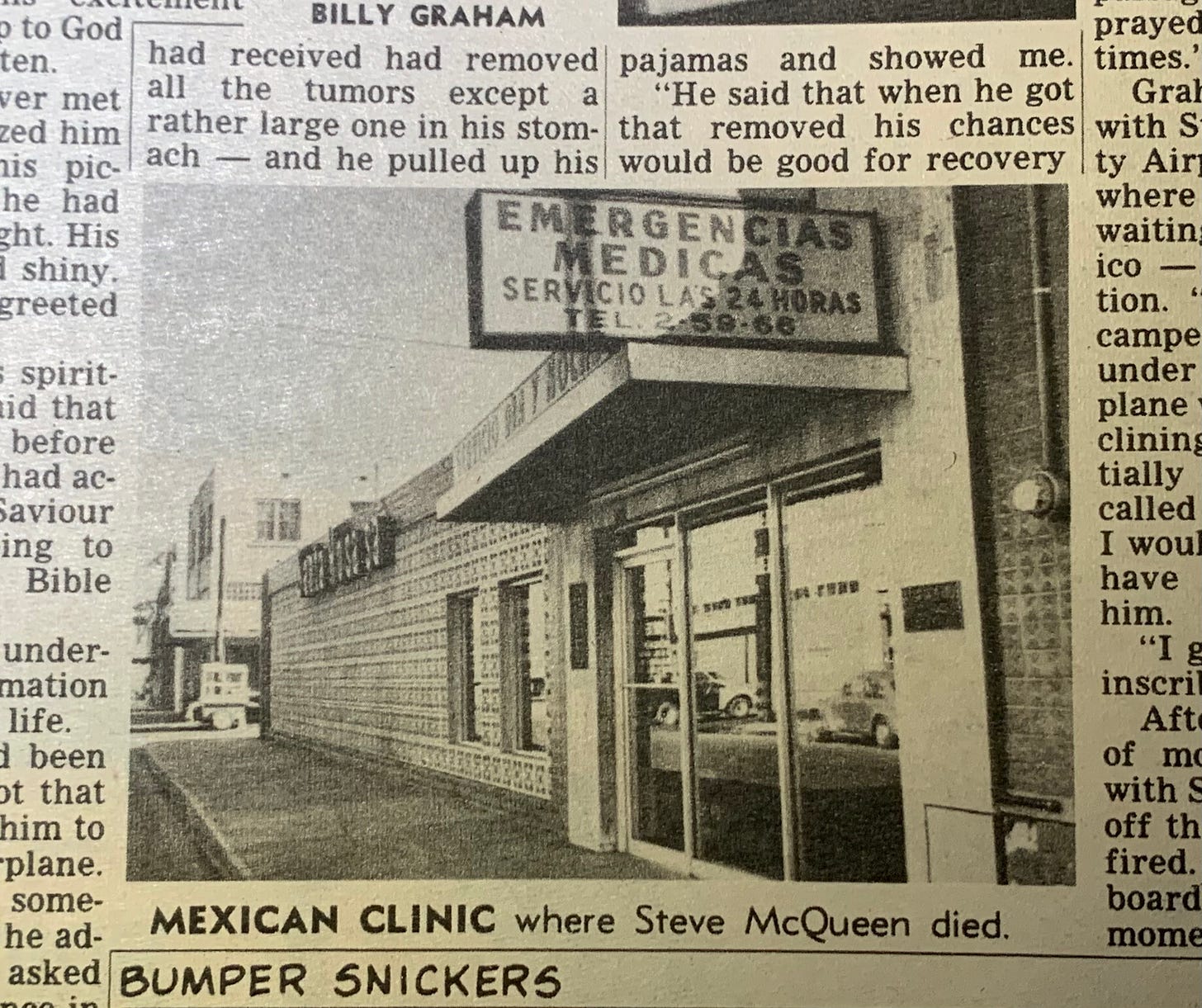
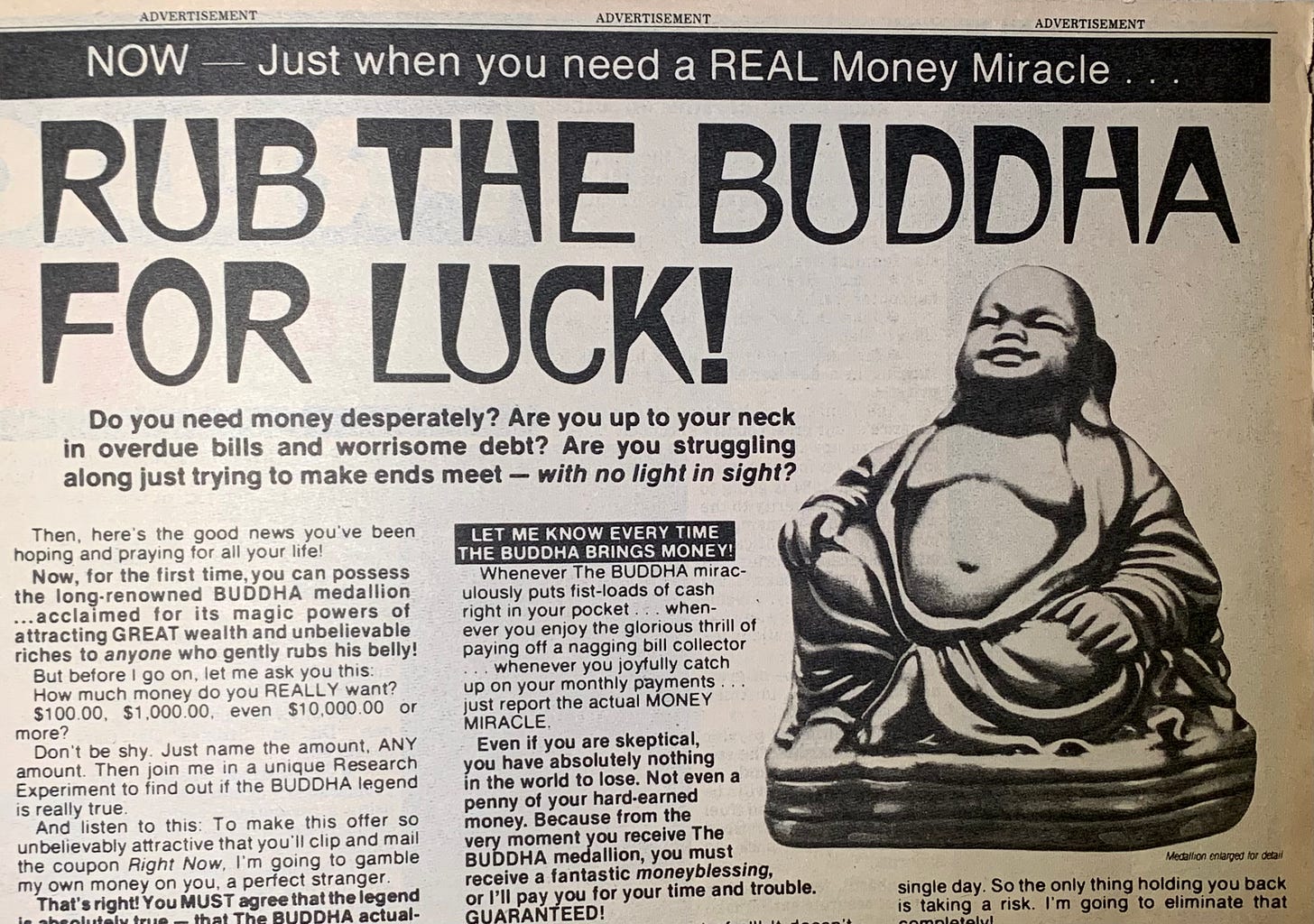
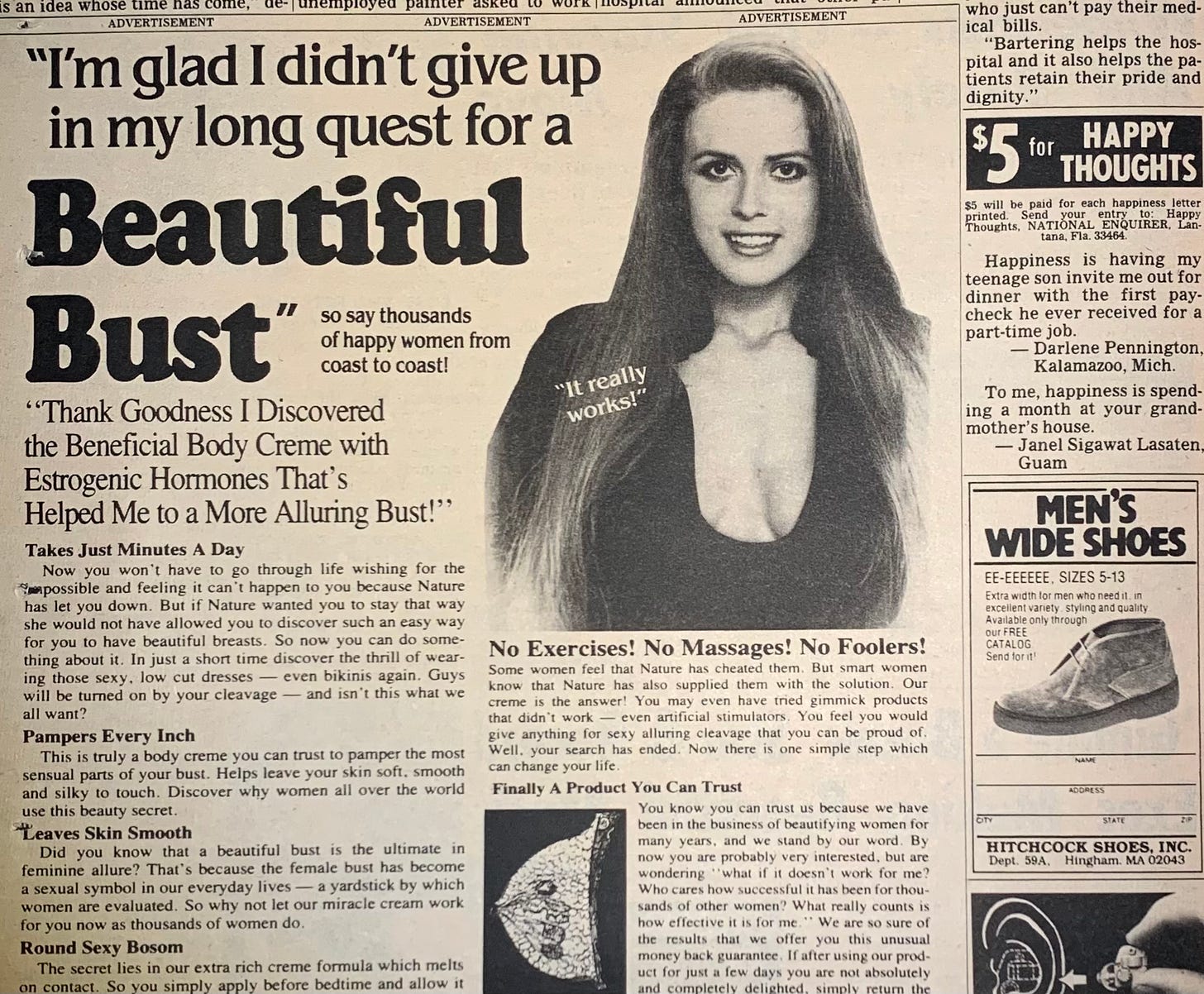
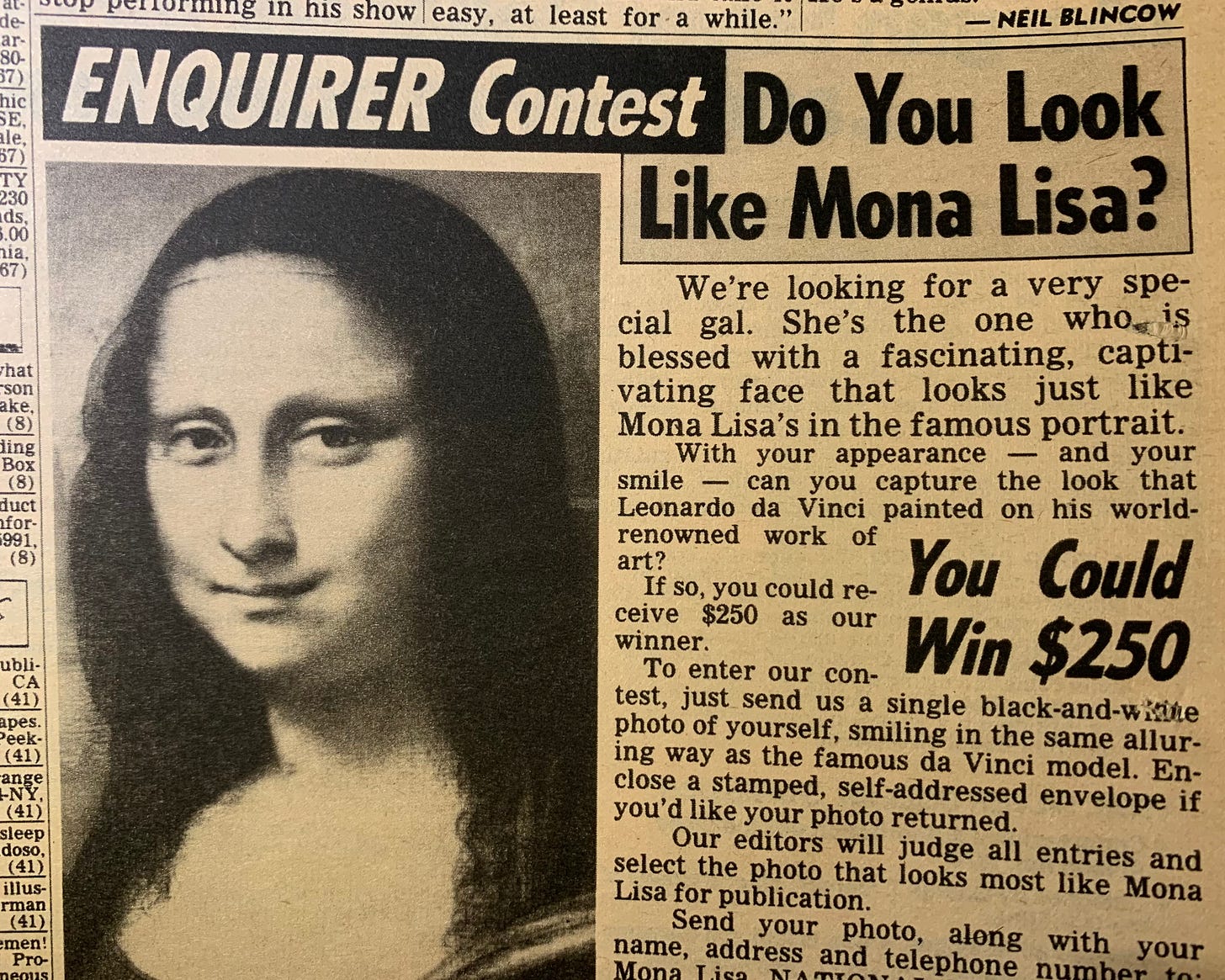


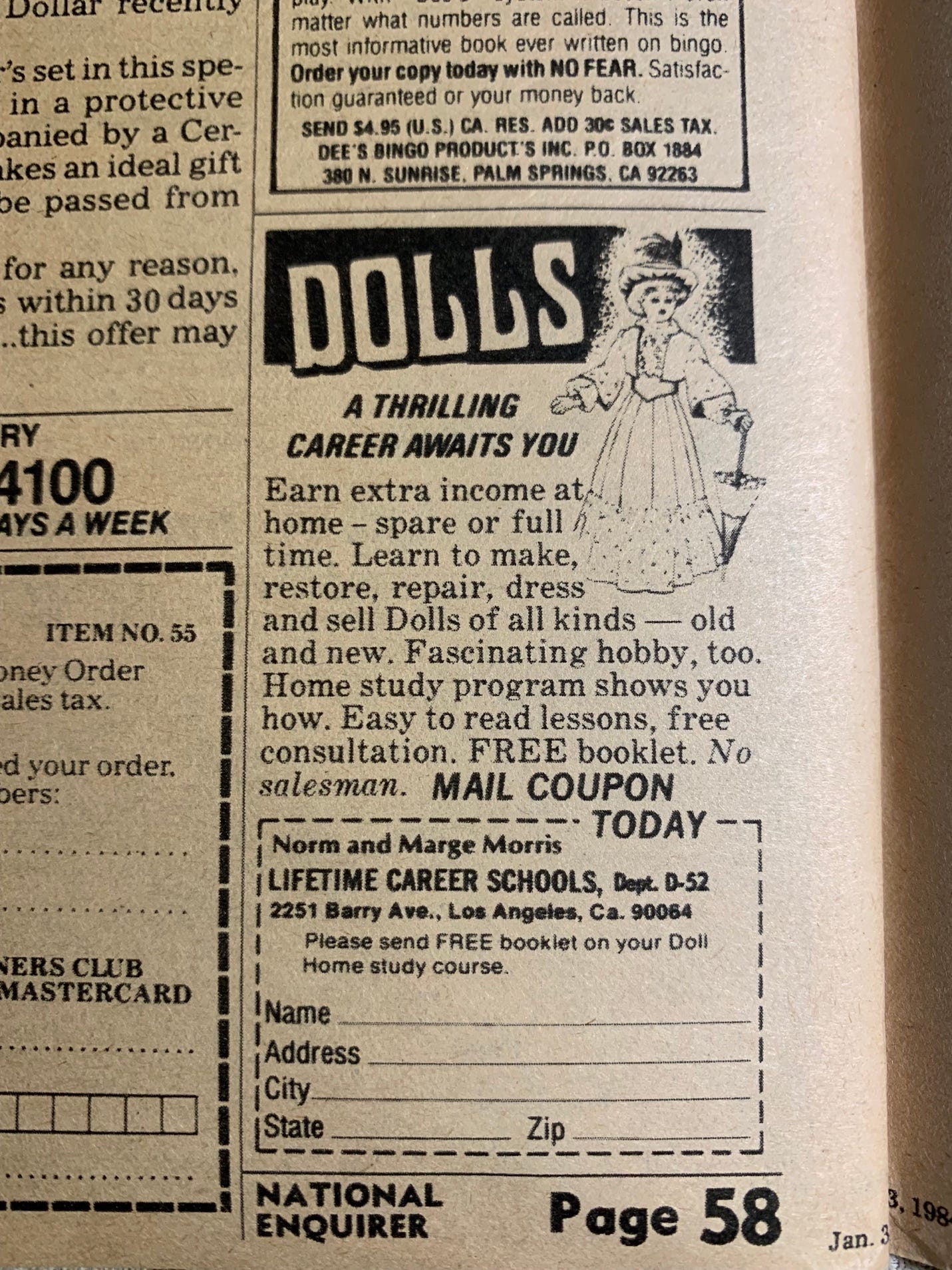
Absolutely fantastic, strange piece. There is something perpetually weird about the passage of time, which everybody knows and yet it stays weird, and you handle it superbly. I'm old enough to remember that era, and those ads and celebrities, the banalities of the time . . . but so of the time! And I loved the ending. Kudos and thanks.
I enjoyed this a lot. Perfect insomnia reading, somewhere on the edge of consciousness. A half dredged memory, half dream. I think Back to the Future came out that same year, 1984, but we’ve always been able to time travel. I spent a year in El Paso, Texas, as an exchange student in 1987 and there I am again, in that hot beige world. Thank you, Mr Kalder.